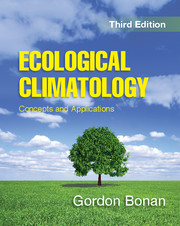Book contents
- Frontmatter
- Dedication
- Contents
- Preface
- 1 Ecosystems and Climate
- Part I The Earth System
- Part II Global Physical Climatology
- Part III Hydrometeorology
- Part IV Biometeorology
- Part V Terrestrial Plant Ecology
- 18 Plant Strategies
- 19 Populations and Communities
- 20 Ecosystems
- 21 Soil Biogeochemistry
- 22 Vegetation Dynamics
- 23 Landscapes and Disturbances
- 24 Global Biogeography
- Part VI Terrestrial Forcings and Feedbacks
- Appendix
- Index
- Plate section
- References
20 - Ecosystems
from Part V - Terrestrial Plant Ecology
Published online by Cambridge University Press: 05 November 2015
- Frontmatter
- Dedication
- Contents
- Preface
- 1 Ecosystems and Climate
- Part I The Earth System
- Part II Global Physical Climatology
- Part III Hydrometeorology
- Part IV Biometeorology
- Part V Terrestrial Plant Ecology
- 18 Plant Strategies
- 19 Populations and Communities
- 20 Ecosystems
- 21 Soil Biogeochemistry
- 22 Vegetation Dynamics
- 23 Landscapes and Disturbances
- 24 Global Biogeography
- Part VI Terrestrial Forcings and Feedbacks
- Appendix
- Index
- Plate section
- References
Summary
Chapter Summary
This chapter extends the discussion of the preceding chapter from that of populations and communities to their functioning as ecosystems. Plants interact with one another and with soil resources as an ecosystem. The soil matrix provides water, nutrients, and other resources required for growth and survival. The availability of these resources to sustain plant growth is modulated by biological activity from plants themselves and also from microorganisms in the soil. The concept of an ecosystem embodies the interrelationships between the physical and biological environments. A terrestrial ecosystem combines living organisms and their physical environment into a functional system linked through a variety of biological, chemical, and physical processes. The structure of an ecosystem is measured by the amount of materials such as carbon and nitrogen and their distribution among living, decaying, and inorganic components. The functioning of an ecosystem is measured by processes such as photosynthesis, respiration, evapotranspiration, and elemental cycling. Plant productivity and nutrient cycling are tightly linked. High nutrient availability leads to high nutrient uptake during plant growth and high net primary production so that more nutrients return to the soil in litterfall. The good quality of the litter allows for rapid decomposition and mineralization, which reinforces the high nutrient availability. Low nutrient availability has the opposite effect. Ecosystem experiments measure responses to CO2 enrichment, warming, and nitrogen addition and provide insight to the ecological consequences of global environmental change.
The Ecosystem Concept
The debate within ecology of the nature of plant communities is tied to the emergence of ecosystems as a unit of study and ecosystem ecology as a field of specialization. A terrestrial ecosystem is the sum of individual organisms interacting with their neighbors to acquire the resources essential for growth and development and interacting with the physical environment to alter resource availability and the characteristics of the environment. It combines all living organisms (plants, animals, and microbes) and their physical environment into a functional system linked through biological, chemical, and physical processes. It includes climate, living and decomposing material, soil, and the circulation of energy and materials that link them.
- Type
- Chapter
- Information
- Ecological ClimatologyConcepts and Applications, pp. 328 - 357Publisher: Cambridge University PressPrint publication year: 2015



